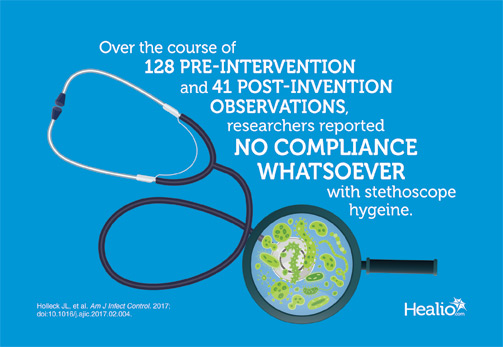Stethoscope hygiene nonexistent even after educational intervention
Click Here to Manage Email Alerts
Stethoscope hygiene compliance remained nonexistent, even after a pilot educational intervention, according to recently published findings from the American Journal of Infection Control.
“Hand hygiene has traditionally received much more attention than stethoscope hygiene, but microbiology data have shown that stethoscope contamination after a single exam is comparable to that of the physician’s dominant hand,” Jurgen L. Holleck, MD, assistant professor in the department of internal medicine at Yale University School of Medicine, and colleagues wrote. “Potential pathogens cultured from stethoscopes include Staphylococcus aureus, Pesudomonas aeruginosa, Clostridium difficile and vancomycin-resistant enterococci.
Despite this evidence, Holleck and colleagues pointed out that stethoscope hygiene rates have been “abysmal” in recent studies.
“Many providers may not be aware of the current guidelines that noncritical medical equipment (including stethoscopes) undergo disinfection between patients,” they wrote.
The researchers documented the use of alcohol swabs or gel for stethoscope and hand hygiene at the beginning of a 4-week rotation of medical students, resident physicians and attending physicians in a tertiary care Veterans Affairs hospital. Hand sanitizer dispensers were available in hallways, and staff viewed a presentation on stethoscope hygiene. Furthermore, flyers were left in staff work spaces and in each nursing unit, along with alcohol swabs.
Holleck and colleagues reported no significant changes in hand hygiene compliance: 58% at baseline and 63% after the intervention. However, over the course of 128 pre-intervention and 41 post-intervention observations, the researchers reported no compliance whatsoever with stethoscope hygiene.
“We anticipated low stethoscope hygiene rates but were surprised that no one performed stethoscope hygiene, despite the fact that it is on the checklist for second-year medical students’ final evaluation demonstrating competency in performing a complete history and physical at our institution,” Holleck and colleagues wrote, adding that the presentation on stethoscope hygiene appeared to be well-received and included a notice that the hospital was planning to monitor compliance.
Researchers acknowledged that the study was limited by a small number of observations, particularly after the intervention was implemented.
“Despite limitations, we think this highlights an important, but often overlooked infection control issue by discovering how rarely stethoscope hygiene is done, and suggests that standard education may not be the answer,” they wrote. “Perhaps accountability can be increased by designating a team member, such as a senior resident physician, to be the team leader and champion to remind and ensure that stethoscope and hand hygiene are performed.” – by Andy Polhamus
Disclosure: The researchers report no relevant financial disclosures.


